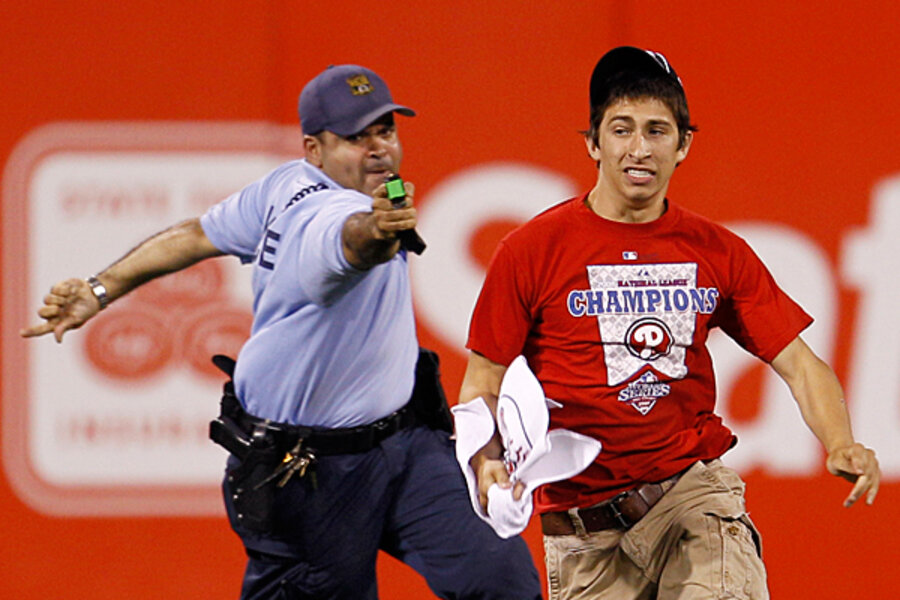Phillies fan tasered: Why police are using Tasers more often
Loading...
| Atlanta
Did the 17-year-old field-runner who got tasered by a Philadelphia police officer at the Phillies-Cardinals game at Citizens Bank Park Monday night have it coming? Or did the police officer struggling to keep pace go too far by firing 50,000 volts at the towel-waving kid in order to crumple him in front of nearly 45,000 fans?
That's the conversation of the day as video of the incident goes viral on the Web and Americans get another chance to weigh the pros and cons of a device that has become a favorite alternative for police officers confronting weaponless lawbreakers.
The number of Tasers in the hands of police have grown to 375,000 worldwide, and the blowback – from "Don't tase me, bro!" to a reported 300 deaths – has been significant.
The Philadelphia Police Department has said that the officer acted in accord with department guidelines, which allow officers to fire their Tasers to subdue fleeing suspects. But judging from the alternating boos and cheers from the crowd, it's far from clear where the public's sentiments lie.
To some, the tasering incident in Philadelphia is indicative of a perceived escalation of threat against police – and how the media has perhaps laid the groundwork for acceptance of Tasers by overhyping that fear.
"[The Phillies fan tasering incident] feels in some ways like a distorted version of what happened in the '60s when people were out of control over fear of war protesters, but now there's fear of almost anyone, like we're at war with ourselves in this country," says Elayne Rapping, a pop-culture expert at the SUNY's University at Buffalo. "It's a slippery slope when we're going to start letting people use weapons of ever more intense destructiveness for small things."
Trespassing on the field is taken seriously by both MLB and law enforcement. But the 17-year-old wearing a red Phillies National League Champions shirt obviously offered no direct threat to players, many of whom reacted by chuckling into their gloves at the wild scene that unfolded.
The Phillies reported it was the first tasering incident for the team, and it's certainly the first one at a professional sports game to be so widely distributed. The scene was not televised as it happened during a commercial break, but fans got a front row seat to an incident that broke into a viral sprint on YouTube.
Wired 96.5-FM's Chio, who hosts the "Good Day" show, reacted with one common refrain that seems to indicate a more sanguine cultural view of the Taser. "I think it's great," Chio said on the air. "You're not supposed to do that … you're looking for attention. Maybe if they know that, 'Oh, snap, I'm gonna get tasered instead of jumped on …,' maybe this might not happen again."
Many police officers argue that cultural criticism of the Taser is largely unfounded since its benefits – the relative safety of the device weighed against fewer injuries to the police officer – are greater than the possibilities for abuse.
"We didn't get this [negative] reaction when nightsticks were used to split heads open, but because of the technology and what it does, the media have really exacerbated the issue of the Taser," former Boca Raton, Fla. police chief Andrew Scott told the Monitor in 2008.
A number of recent cases have tested the legality of using the Taser on unarmed suspects, but so far the constitutionality of its use has not been firmly established. Notably, the US Supreme Court last year refused to take up a case of a handcuffed Florida motorist who was tased three times because he disobeyed a deputy sheriff's command to stand up and walk to a patrol car.
The question in many such cases is to what extent police can use a Taser against someone who is passively refusing to obey a police command. Such passive refusal is considered by many officers to be a form of resisting arrest, clearing the way to pull out the Taser. In the Phillies fan tasering incident, the lanky youth was clearly resisting arrest.
"In the end it is all going to come down to a question of reasonableness under the circumstances," Tallahassee lawyer John Jolly told the Monitor last year. "If a reasonable person would think that use of force is going to accomplish a lawful objective and make it less likely that somebody gets hurt, they can do it."
But is the definition of reasonable Taser use shifting in light of the tasering of the Phillies fan?
If it is, Ms. Rapping blames much of it on the media, where a predilection for focusing on crime and out of control citizens "leads people to think that the most dangerous people in the world are young kids at a baseball game, when really the most dangerous people are CEOs and government regulators who endanger lives and jobs [with their failings,]" she says. "We've got our values wrong. We're policing the wrong people."
Related:
Federal court in California limits police use of Tasers
Police Tasers: excessive force or necessary tool?





